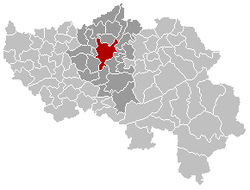Liège (city)
|
Liege Luik (Dutch) Lüttich (German) |
|||
|---|---|---|---|
| Municipality | |||

Late-September 2009 aerial view of Liège
|
|||
|
|||
| Location in Belgium | |||
| Coordinates: 50°38′N 05°34′E / 50.633°N 5.567°ECoordinates: 50°38′N 05°34′E / 50.633°N 5.567°E | |||
| Country | Belgium | ||
| Community | French Community | ||
| Region | Wallonia | ||
| Province | Liège | ||
| Arrondissement | Liège | ||
| Government | |||
| • Mayor | Willy Demeyer (PS) | ||
| • Governing party/ies | PS – cdH | ||
| Area | |||
| • Total | 69.39 km2 (26.79 sq mi) | ||
| Population (1 January 2016) | |||
| • Total | 196,970 | ||
| • Density | 2,800/km2 (7,400/sq mi) | ||
| Postal codes | 4000–4032 | ||
| Area codes | 04 | ||
| Website | www.liege.be | ||
Liège (French pronunciation: [ljɛʒ], lieːʃ in Belgium; Walloon: Lidje; Dutch: Luik, [lœyk]; German: Lüttich) is a major city and a municipality in Belgium. It is the main city of the province of the same name, Liège, in Belgium's francophone region of Wallonia.
The city is situated in the valley of the Meuse River, in the east of Belgium, not far from borders with the Netherlands (Maastricht is about 33 km (20.5 mi) to the north) and with Germany (Aachen is about 53 km (32.9 mi) north-east). At Liège the Meuse river meets the river Ourthe. The city is part of the sillon industriel, the former industrial backbone of Wallonia. It still is the principal economic and cultural centre of the region.
The Liège municipality (i.e. the city proper) includes the former communes of Angleur, Bressoux, Chênée, Glain, Grivegnée, Jupille-sur-Meuse, Rocourt, and Wandre. In November 2012, Liège had 198,280 inhabitants. The metropolitan area, including the outer commuter zone, covers an area of 1,879 km2 (725 sq mi) and had a total population of 749,110 on 1 January 2008. This includes a total of 52 municipalities, among others, Herstal and Seraing. Liège ranks as the third most populous urban area in Belgium, after Brussels and Antwerp, and the fourth municipality after Antwerp, Ghent and Charleroi.
...
Wikipedia




